Creative and Visually Appealing Outdoor Flower Pot Ideas
Imagine stepping into your backyard and being greeted by a burst of color and texture, all thanks to a few well-placed flower pots. There’s something undeniably satisfying about transforming an outdoor space with the simple addition of vibrant blooms and lush greenery. Whether you have a sprawling garden or a cozy balcony, flower pots offer an easy and versatile way to elevate your outdoor area.
Flower pots aren’t just about adding beauty; they can also reflect your personality and style. From sleek, modern containers to rustic, weathered pots, the choices are endless. This guide will walk you through the process of selecting the right materials, picking the best plants, and making the most of your space. By the end, you’ll have all the tools you need to create a stunning outdoor display that’s uniquely yours.
Choosing the Right Material
Selecting the right material for your flower pots is crucial for both aesthetics and functionality. Each type of material has its benefits and drawbacks, impacting the overall look and maintenance of your garden. Here’s a breakdown of some popular options to help you decide which one suits your needs best.
Terracotta Pots
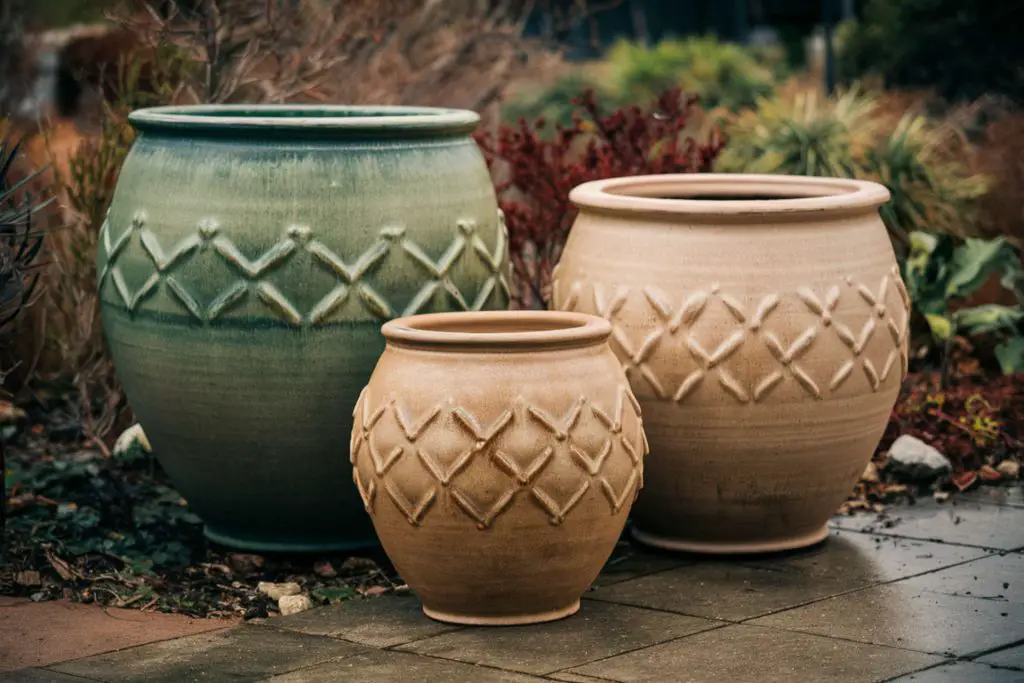
Benefits:
- Classic look that ages beautifully.
- Porous nature allows for good air circulation to the roots.
Drawbacks:
Ceramic Pots

- Can be heavy, making them difficult to move.
- Prone to cracking in cold weather.
Benefits:
- Available in various colors and patterns, adding a vibrant touch to your garden.
- Glazed finish helps retain moisture, reducing watering frequency.
Drawbacks:
- Generally more expensive than other options.
- Heavy and can break easily if dropped.
Plastic Pots
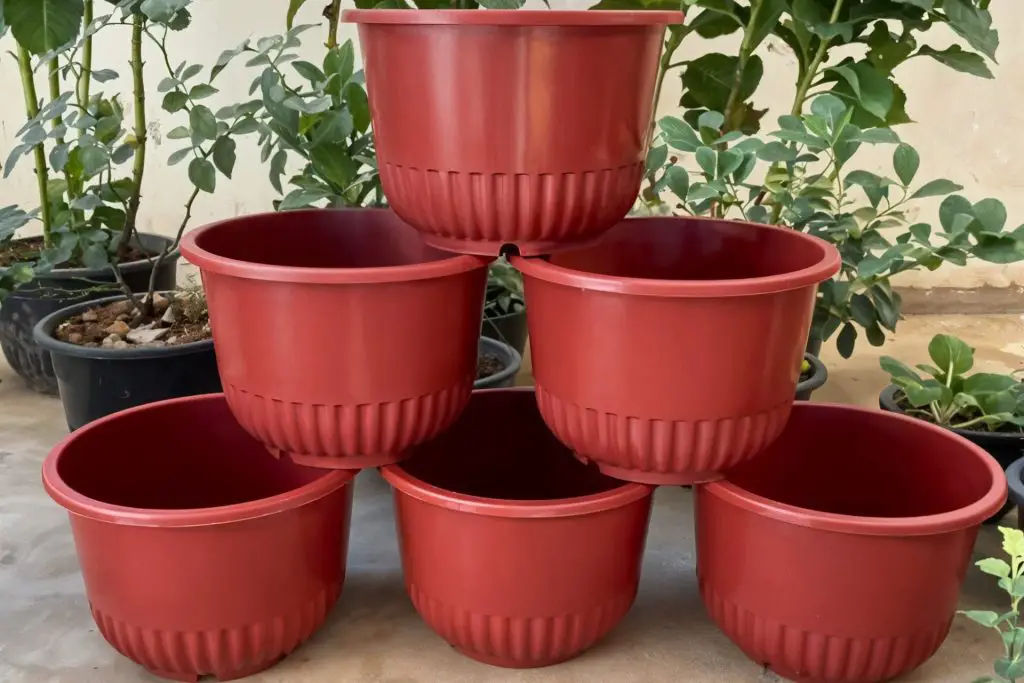
Benefits:
- Lightweight and easy to move around, making them ideal for those who like to rearrange their garden frequently.
- Affordable and available in numerous styles and sizes.
Drawbacks:
- Less durable, often fading or becoming brittle over time.
- Can look less sophisticated than other materials.
Metal Pots
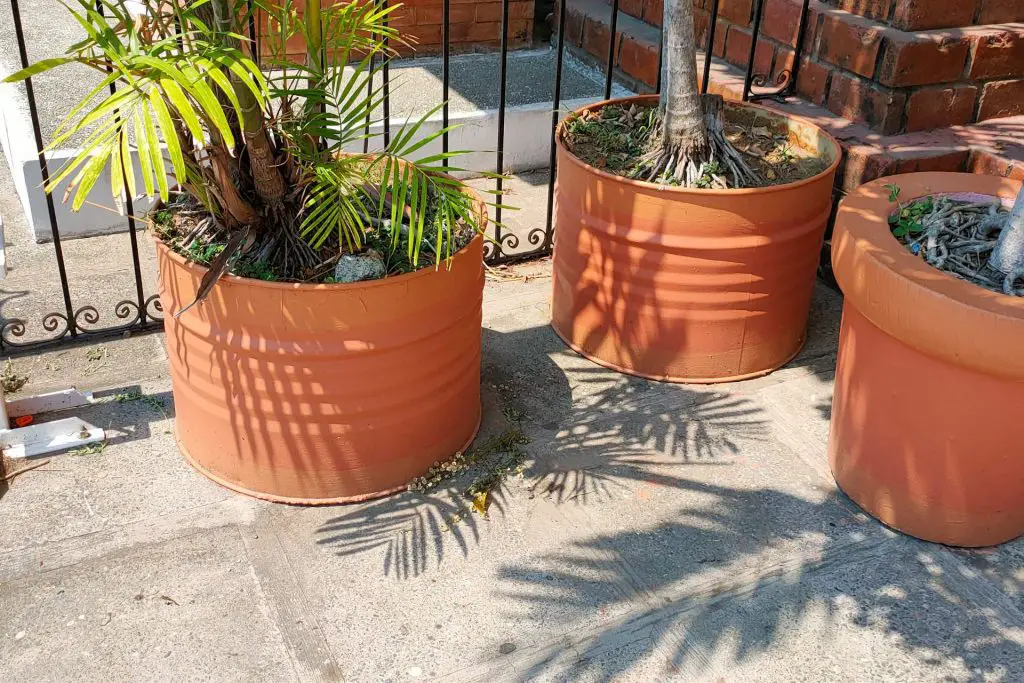
Benefits:
- Sleek, modern appearance that fits well with contemporary garden designs.
- Highly durable and long-lasting.
Drawbacks:
- Can overheat in direct sunlight, potentially harming plant roots.
- May rust if not properly treated or maintained.
Wooden Pots
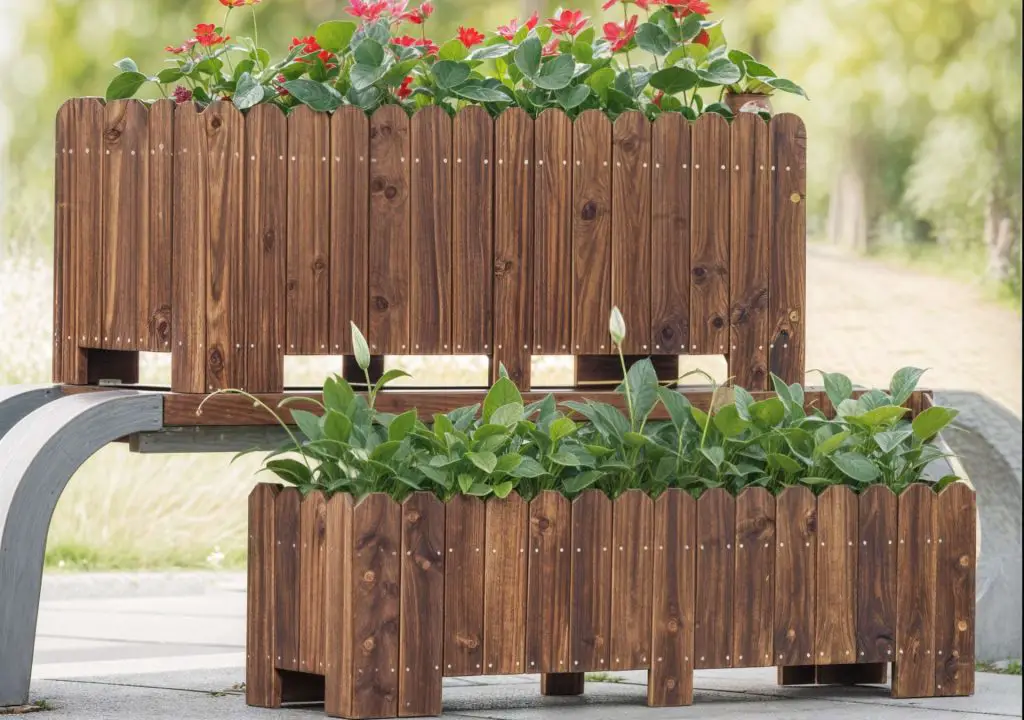
Benefits:
- Natural look that blends seamlessly with outdoor environments.
- Can be customized or built to specific sizes.
Drawbacks:
- Requires regular maintenance to prevent rotting and pest infestations.
- Can be heavy, especially when filled with soil and plants.
Obviously, there are pros and cons with each material, you can make an better informed decision that complements your garden’s style adheres to the aesthetic you are looking for, and meets your practical needs.
Stone and Concrete Planters
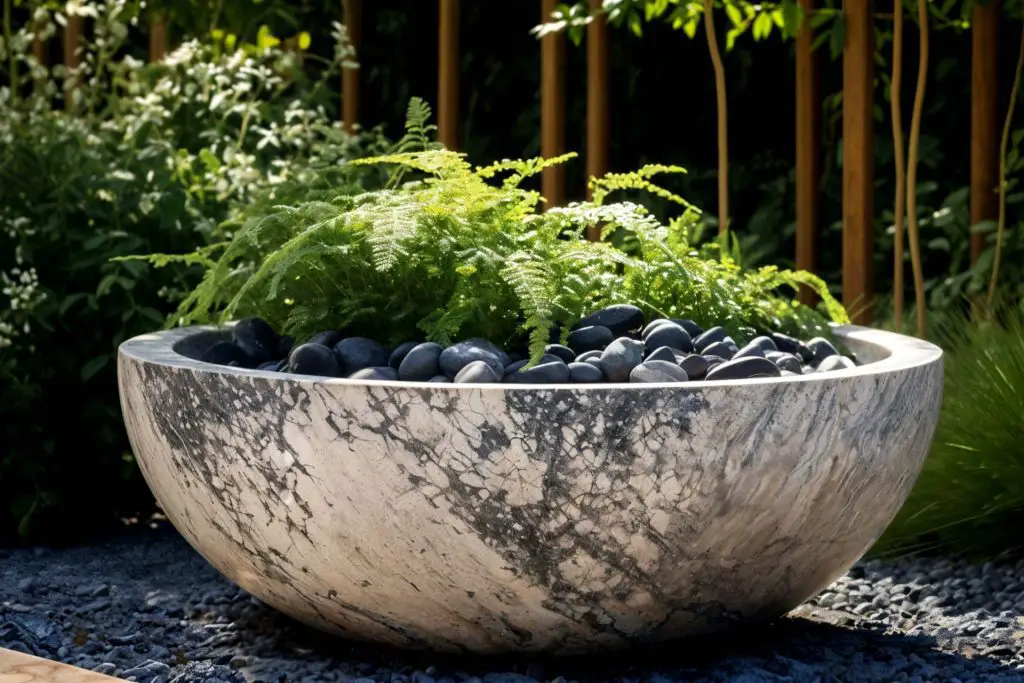
Benefits:
- Extremely durable and long-lasting.
- Offer a sturdy and stable base for larger plants.
- Provide a classic and elegant look that can suit various garden styles.
Drawbacks:
- Very heavy, making them difficult to move once placed.
- Can be expensive compared to other materials.
- May require additional insulation to protect plant roots from extreme temperatures.
Stone and concrete planters add a timeless appeal to any garden, combining strength with aesthetic
Selecting the Best Plants for Your Pots
Choosing the right plants for your outdoor flower pots can transform your garden into a vibrant oasis. The key is to select plants that thrive in your specific conditions and create visually appealing arrangements. Here are some suggestions based on sunlight requirements and a popular planting technique.
Sun-loving Plants
Examples:
- Geraniums
- Petunias
- Marigolds
Tips: Ensure these plants receive plenty of direct sunlight to flourish. Placing them in areas with at least six hours of sunlight each day will help them thrive and bloom beautifully.
Shade-loving Plants
Examples:
- Ferns
- Hostas
- Impatiens
Tips: Ideal for patios or garden areas with limited sun exposure. These plants do well in shaded spots, adding lush greenery and pops of color where other plants might struggle.
Mixed Arrangements
Thriller, Filler, Spiller Technique: This method involves combining different types of plants to create dynamic and visually interesting pots.
Examples:
- Thrillers: Tall, focal point plants like grasses or spiked flowers.
- Fillers: Mid-height, bushy plants such as begonias or pansies.
- Spillers: Trailing plants like ivy or creeping Jenny that hang over the edges of the pot.
Using this technique, you can create balanced and eye-catching arrangements that draw attention and add depth to your garden space.
Selecting the right plants and arranging them thoughtfully can make a significant difference in the overall look and health of your outdoor flower pots. Tailor your choices to your garden’s specific conditions and your personal style to create a space that feels both welcoming and vibrant.
Considering Garden or Patio Size
The size of your garden or patio plays a significant role in selecting and arranging flower pots. Different strategies work best for small, medium, and large spaces, ensuring you make the most of your available area.
Small Spaces
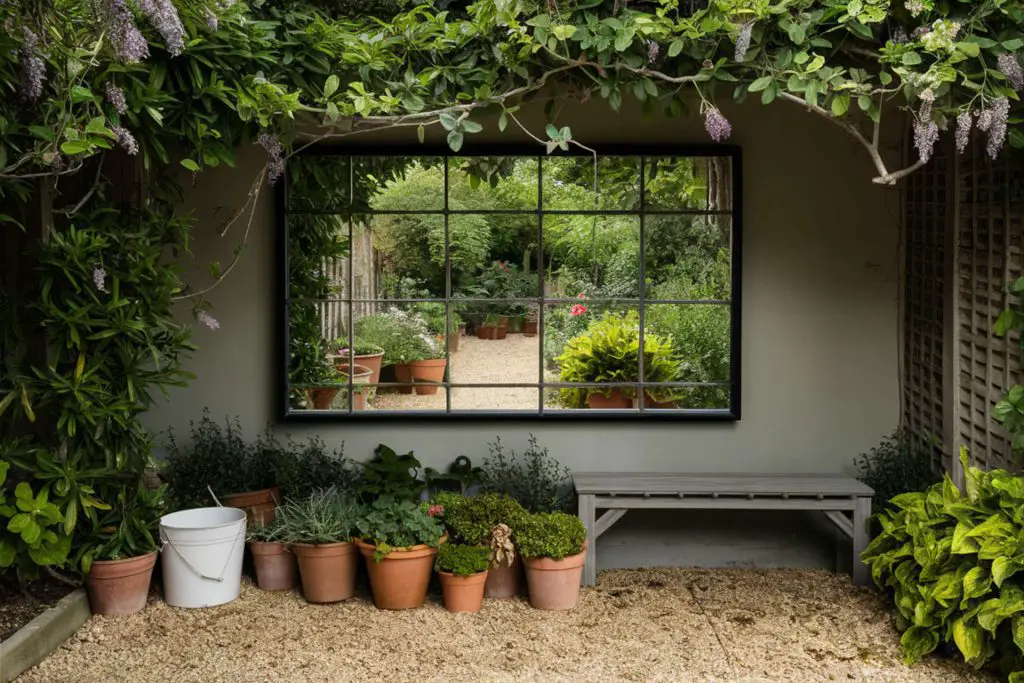
Ideas:
- Vertical gardens: Use wall-mounted planters or tiered plant stands to maximize space.
- Hanging pots: Save floor space and add greenery at eye level.
- Compact pots: Choose smaller pots and plants to avoid overcrowding.
Tips: Think vertically and use creative solutions to add plants without taking up valuable ground space. Grouping small pots together can create a mini garden that feels lush without being overwhelming.
Medium Spaces
Ideas:
- Grouping pots: Combine pots of different sizes and heights for a layered look.
- Defining spaces: Use pots to create boundaries or separate areas within your garden or patio.
- Statement pots: Add a few larger pots as focal points among smaller ones.
Tips: Balance is key. Mix and match pot sizes and shapes to create visual interest while maintaining a cohesive look. Use pots to guide the flow of the space and create distinct areas for different activities.
Large Spaces
Ideas:
- Large statement pots: Use big, bold pots to make a statement and fill space effectively.
- Container gardens: Create dedicated areas with clusters of pots for a garden-like feel.
- Integrating pots: Place pots within garden beds or along pathways to enhance the landscape.
Tips: Experiment with different styles and arrangements to create a dynamic and engaging outdoor area. Large spaces allow for more creativity and variety, so feel free to mix materials and plant types for a rich, layered look.
Tailoring your flower pot choices and arrangements to the size of your garden or patio ensures that your space feels well-designed and welcoming. With thoughtful planning, you can create a beautiful and functional outdoor area, no matter how large or small.
Creative Design Ideas
Injecting creativity into your outdoor flower pot arrangements can elevate your garden’s appeal. Here are some imaginative design ideas to inspire your next project.
Color Themes
Monochromatic: Using pots and flowers of the same color creates a cohesive and elegant look. For instance, white pots with white flowers can give a clean and modern feel.
Complementary Colors: Pair colors that enhance each other. For example, blue pots with orange flowers create a striking contrast that draws the eye.
Seasonal Themes
Spring: Pastel-colored pots filled with tulips and daffodils welcome the fresh energy of spring. Consider mixing light pinks, soft blues, and gentle yellows for a harmonious blend.
Summer: Bright, vibrant pots with sunflowers and zinnias capture the lively spirit of summer. Bold reds, oranges, and yellows will make your garden pop with color.
Fall: Earth-toned pots with mums and ornamental cabbages reflect the rich hues of autumn. Use deep reds, oranges, and purples to mirror the changing leaves.
Recycled and Upcycled Containers
Examples: Old buckets, vintage tins, and wooden crates can become unique flower pots. These repurposed items add character and charm to your garden.
Benefits: Using recycled materials is eco-friendly and gives your garden a distinctive, personalized look. Plus, it’s a great way to reduce waste.
Themed Arrangements
Herb Gardens: Plant a variety of herbs in a series of matching pots for a functional and fragrant addition to your outdoor space. Basil, rosemary, and thyme are excellent choices.
Succulent Displays: Create a desert-inspired arrangement with various succulents in shallow, wide pots. These low-maintenance plants come in many shapes and colors, adding visual interest.
Fairy Gardens: Small plants and whimsical decorations can transform a pot into a magical miniature garden. Use moss, tiny figurines, and small flowering plants to create an enchanting scene.
Bringing creative design ideas into your garden can make your outdoor space uniquely yours. Experiment with different themes, colors, and materials to discover what best reflects your style and brings joy to your gardening experience.
Spiritual Gardens

Design Elements: Incorporate elements that promote tranquility and reflection. Pots with lavender, sage, and jasmine can create a calming atmosphere. Adding small statues, wind chimes, and smooth stones enhances the spiritual vibe.
Benefits: These gardens provide a peaceful retreat for meditation and relaxation. The soothing scents and serene visuals contribute to a sense of well-being and mindfulness.
Secret Gardens
Design Elements: Create a hidden space with pots strategically placed to form a secluded nook. Use climbing plants like ivy or jasmine to add privacy and mystery. Flowering plants like hydrangeas and ferns can create lush, green surroundings.
Benefits: A secret garden offers a private escape within your own outdoor space. It’s perfect for reading, relaxing, or enjoying a quiet moment away from the hustle and bustle.
Bringing creative design ideas into your garden can make your outdoor space uniquely yours. Experiment with different themes, colors, and materials to discover what best reflects your style and brings joy to your gardening experience.
Practical Tips for Maintenance
Keeping your outdoor flower pots looking their best requires some ongoing care. Regular maintenance ensures your plants stay healthy and vibrant. Here are some practical tips to help you maintain your flower pots effectively.
Watering
Frequency: The watering schedule depends on the plant type and pot material. Terracotta pots, for example, dry out faster than plastic ones. Check the soil moisture regularly and water when the top inch feels dry.
Methods: Consider using drip irrigation systems for consistent watering. Self-watering pots are another convenient option, reducing the frequency of manual watering.
Fertilizing
Types: Both organic and synthetic fertilizers can be used. Organic options like compost and fish emulsion are great for a natural approach, while synthetic fertilizers provide quick nutrient boosts.
Schedule: Regular feeding is crucial for optimal growth. During the growing season, fertilize your plants every 2-4 weeks, following the specific needs of each plant.
Winter Care
Tips: Protect your pots and plants during the colder months. Bring delicate pots indoors or to a sheltered area. Use frost-resistant pots for plants that stay outside. Mulching can also help insulate the soil and roots.
Consistent maintenance ensures your flower pots remain a beautiful and thriving part of your outdoor space. With proper care, your plants will continue to flourish and bring joy throughout the seasons.
Final Thoughts
Transforming your outdoor space with creative and visually appealing flower pots can bring immense joy and satisfaction. From selecting the right materials to choosing the perfect plants and incorporating unique design ideas, every step contributes to a personalized and vibrant garden.
Whether you have a small balcony or a large patio, thoughtful planning and maintenance will ensure your flower pots remain a stunning feature. Embrace the process, experiment with different styles, and most importantly, have fun creating a space that reflects your personality and love for gardening.
Enjoy the beauty and tranquility that well-chosen flower pots can bring to your outdoor area, making it a place of relaxation and inspiration.
